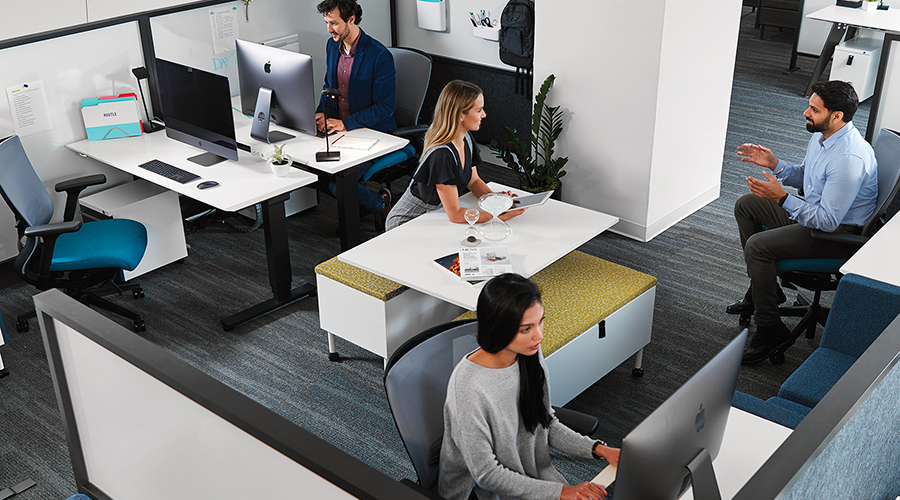Designing a Flexible Workplace for All Generations

From a generation that watched humans walk on the moon to another that has never known life without a computer, today’s workplace designers and managers face a broad swath of experiences, preferences and expectations from employees.
With four generations now operating in the workplace, much has been made of the stereotyping and interactions among them. There’s no arguing Baby Boomers, Gen X, Millennials and Gen Z – who are just beginning to enter the workforce - have their differences. But they also share common ground, which can serve as the foundation for creating workspaces that appeal to all employees.
Lindsey Pollak, author of The Remix: How to Lead and Succeed in the Multigenerational Workplace, provides some insights around the generations who comprise today’s typical office:
- Baby Boomers (1946-1964) – Many Boomers prioritize work over family obligations as they did not have the technology available to work from anywhere but the office when they entered the work force. They can sometimes be less supportive of flexible work policies.
- Generation X (1965-1980) – Described as skeptical and also as tech pioneers, Gen X grew up self-reliant. Self-reliance helped fuel their independent instincts that led many to move to Silicon Valley and launch many of the tech tools used today.
- Millennials (1981-1997) - Also known as digital natives, these young professionals were brought up with the internet. Technology has had a major impact on how they see the world and interact with others — think texting and instant messaging vs face-to-face or phone communication. They also expect information to be just one click away.
- Gen Z (1998-2015) – Cautious, technologically-advanced and diverse, 61 percent of (Gen Z) high school students say they want to be an entrepreneur rather than an employee. As children who came of age following the Great Recession, they likely share some of the cautious, frugal characteristics of their traditionalist fore-bearers.
With such a wide range of backgrounds and personal tendencies, what commonalities exist in order to create a productive culture and to design a cohesive workplace?
Workplace Flexibility
All generations place a premium on flexibility, both in work/life balance and in the physical work environment itself.
Work/life balance is important regardless of age. Employees find themselves in the position of having to care for elderly parents, having to attend their children’s school events, wanting to incorporate a workout into their day or just appreciating the opportunity to work remotely when necessary.
These expectations, along with technological advancements, have led to dramatic workplace design changes over the last two decades. Layouts have shifted from private offices and assigned cubicles to open plans that accommodate various work style preferences – focused work, interaction, ideation and regenerative. Well-designed offices meet a variety of needs, offering spaces like touchdown areas, cafés and lounges, benching and private environments.
Designing for and providing a variety of spaces ensures that each employee, regardless of age, has a place where he or she feels comfortable and productive.
Employees also desire flexibility within their personal workspace. They appreciate the ability to rearrange furniture to accommodate their personal preferences – on demand, without involving facilities. This request is quickly becoming a driving force in workplace design.
A Capital One survey indicated 83 percent of workers say an adaptable and engaging workplace is vital to innovative work. It also revealed easily-reconfigurable furniture and spaces are the second most sought after design element behind natural light.
User Control
KI’s Tattoo Collection was designed around workplace personalization and user control. The collection consists of four main elements – slim seating, screens, adjustable-height tables and storage – all of which work seamlessly together or independently, and can be rearranged on the fly. Tattoo empowers employees to change their workspace to fit work styles or their larger team needs.
From a generational standpoint, Baby Boomers or Gen Xers who want more privacy may reposition screens while Millennials who thrive on collaborative work may gravitate toward moving their desks together to create a shared space. As roles, responsibilities and preferences change, so can the office footprint.
Health is Wealth
When it comes to health and wellness at work, there are no generational disputes over the value. It’s a topic many companies - including KI - have adopted as a business strategy to improve health, increase productivity and manage insurance premiums. Programs like onsite nurses and annual health risk assessments not only promote healthy habits but also demonstrate that an organization cares about the well-being of its employees.
It’s becoming more common to plan for dedicated mothers’ rooms to support moms returning to work. These spaces can be specified in ways to also accommodate those suffering from illnesses like migraines or for those who need a place for a short reprieve. On-site fitness studios and health-conscious cafés are also becoming the norm.
Businesses and designers focused on improving employee well-being are leveraging Active Design principles to encourage movement. Turning sedentary office environments into spaces that can encourage healthier lifestyles is the central idea behind Active Design. Sit-stand desks are a great way to encourage movement. Movement can also be increased by purposely interspersing destinations such as café or lounge spaces throughout a building.
From Z to Alpha
A lot has been said about Millennials and their role in changing the workplace but Gen Z, employees just now entering the workforce (61 million in total), are already inciting change. Adaptive workspaces will be increasingly important. They are a generation that places a high value on teamwork and face-to-face interaction. They also appreciate having a workstation they can personalize and call home.
Designing for workplace flexibility is key to recruiting and retaining not just Gen Z, but all generations. Stay tuned because it won’t be long before we’re talking about Gen Alpha! It’s a little early to draw any clear conclusions about this generation's workplace expectations but they will no doubt push the workplace design conversation even further.
Subscribe
Stay up to date with the latest trends and more.
